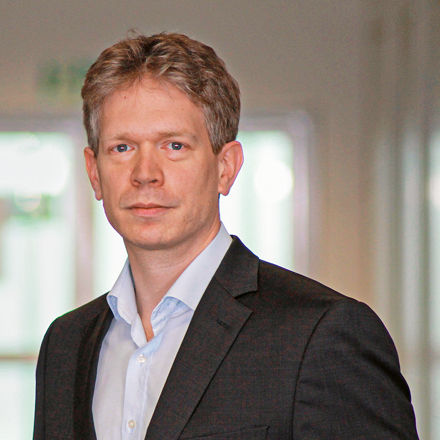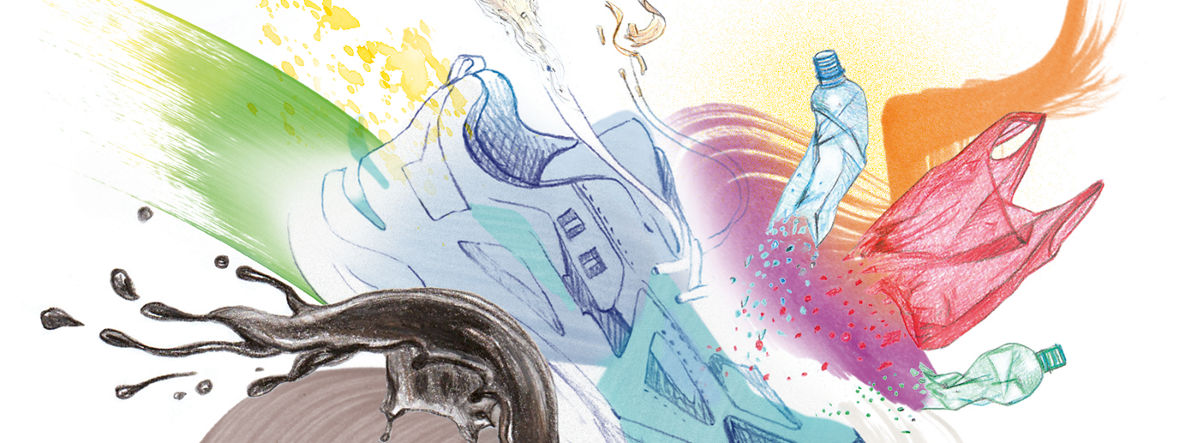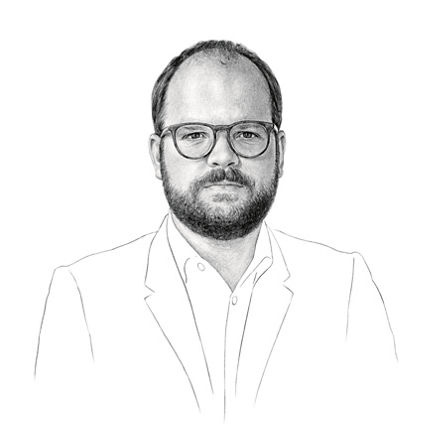Energy and mobility can be decarbonized, but not the chemical industry,” says Jeroen Verhoeven. Carbon is much too important a component of chemical compounds to be replaced. There’s hardly any product that contains no carbon atoms at all.
Verhoeven works at Neste, a Finnish company that is the world’s biggest producer of diesel and aviation fuel based on renewable sources. The company has worked together with Evonik in the past to develop lubricant formulations. By its own account, through its products Neste prevented the emission of about eleven million tons of greenhouse gases in 2021 alone. In recent years the company has increasingly turned to alternative sources of carbon for chemistry.

»Energy and mobility can be decarbonized, but not the chemical industry«
JEROEN VERHOEVEN VICE PRESIDENT PRODUCTION PARTNER MANAGEMENT, RENEWABLE POLYMERS AND CHEMICALS AT NESTE
The demand is tremendous. According to a study conducted by the nova-Institute, a German think tank, the chemical products manufactured all over the world every year contain about 450 million tons of carbon. This amount will more than double by the year 2050.
That’s why the chemical sector is searching for alternatives to natural gas and petroleum with increasing urgency. It is examining all kinds of materials, ranging from used tires to cellulose waste, that can keep carbon in circulation and stop the extraction of new carbon from the earth.
ELEMENTS-Newsletter
Get exciting insights into Evonik's research and its social relevance – conveniently delivered to your inbox.
Evonik has developed a material from renewable sources: TROGAMID® myCX eCO, a transparent polyamide that was specially formulated for eyeglass lenses. The BOSS brand is now presenting the first collection of sunglasses made with this product. The abbreviation eCO stands for “eliminate CO₂.” This climate-friendly innovation generates only half as much carbon dioxide emissions as conventional polyamide, because its production uses renewable energy and 40 percent of the fossil raw materials are replaced with renewables. “We want to help shrink Evonik’s CO₂ footprint,” says Dr. Florian Hermes, the expert responsible for the topic at the High Performance Polymers business line at Evonik.

Today, in the sector as a whole, 85 percent of the carbon in chemical products comes from fossil sources. Over three fourths of this comes from petroleum and one fourth comes from natural gas. Only a tenth of chemical products are bio-based, and one twentieth are recycled. This mix must be fundamentally changed by 2050. According to the nova-Institute, by then more than half of all carbon should come from recycled materials; the rest should come from cultivated plants and directly from the air. That sounds like a revolution. However, these changes will be carried out step by step. Completely rebuilding global industries such as chemistry, with its complex material flows and gigantic production networks, would not be a viable option. Nor would it make sense from an environmental perspective. The transformation must be achieved by means of the production plants that already exist, by incorporating renewable raw materials in ever greater volumes into the existing processes.
One important method that will help us reach this goal is called the “mass balance approach.” According to this approach, the renewable carbon that is fed into the beginning of a chemical value chain by means of a raw material can be assigned to a certain carbon-containing product at the end of the value chain. In very simplified terms, this is how it works: One ton of vegetable oil that replaces a ton of petroleum in a refinery is credited, for bookkeeping purposes, to a ton of finished plastic that is produced from the refinery’s products. In this process, the vegetable oil and the petroleum do not need to remain separated. The mass balance approach makes it possible to process fossil materials and renewables together. The final balance is calculated at the end of the process.
ATOMIC MASSES INSTEAD OF KILOWATT-HOURS
This is very comparable to the way we deal with renewable electricity. Wind turbines and photovoltaic systems feed electric energy into the same power grid as power plants fired with coal and natural gas. Customers who pay for green electricity don’t know where the electrons streaming out of their sockets really originate. However, they pay for the fact that the amount of electricity they use is equal to the amount of electricity from renewable sources that is fed into the grid.
In the chemical industry, this is somewhat more complicated. Instead of kilowatt-hours, we need to trace atomic masses. And we need to trace them through many complex reactions, some of which are closely guarded trade secrets. In order to ensure that this process is carried out correctly and transparently, binding regulations and international standards are necessary. One of the standards is ISCC PLUS.
ISCC stands for International Sustainability & Carbon Certification, an organization based in Cologne. Its PLUS standard ensures that the amount of carbon in the product that is declared as renewable in the calculations is exactly the same as the amount of renewable carbon that was fed into the process. Possible process losses are thus taken into account. Standards such as ISCC EU have been legally binding for biofuels for a long time now. ISCC PLUS was developed for the chemical industry, among other sectors. Compliance with this standard is still a voluntary self-commitment. However, the number of valid ISCC PLUS certificates has recently been doubling year after year. Major producers of consumer goods are already attaching the ISCC PLUS label to packages of baby pacifiers, potato chips, and shampoo. As a result, demand is increasing all along the supply chain.

CRACK-C4 FROM SUSTAINABLE SOURCES
Evonik facilities in Marl and Antwerp have had ISCC PLUS certification since November 2021. They are part of the Performance Intermediates business line, whose products include plasticizers, additives, and intermediates for everything from detergents to shoe soles—around two million tons per year. The most important raw material for these products is called crack-C4. Its molecules, which contain four carbon atoms, are created when crude oil products are cracked. In the future, plans call for more and more of these molecules to be supplied by renewable residue materials from refineries. Whether it’s butadiene for rubber applications or butene for plastics, these substances can be extracted from renewable or recycled sources—and they will be chemically identical to the compounds made from scratch. This is confirmed by the mass balance approach. “Certification according to ISCC PLUS enables us to increase the proportion of sustainable products in line with availability and demand,” says Hendrik Rasch, who is responsible for Business & Sustainability Transformation at the business line.

Demand for certified products of this kind is also increasing within the company itself. For example, butadiene and butene are processed in the Coating & Adhesive Resins business line. The first eCO product made of a defossilized cracker product is already on the market: VESTOPLAST® eCO is processed in the hot-melt adhesives—or hotmelts, in technical jargon—that hold baby diapers together, for example. In this case, reliable adhesion is a must, and people are increasingly demanding sustainability as well. “Today the millennials have kids in diapers, and they’re watching out for eco-labels,” says Dr. Sabrina Mondrzyk, the head of Technical Marketing for Hotmelts. Adhesion is also important in the production of furniture, beverage cartons, and automobiles. And companies such as IKEA are demanding that recycling products be used even for adhesives. “Nonetheless, no company is making compromises when it comes to adhesion performance and processing,” says Mondrzyk. VESTOPLAST® eCO is chemically identical to the conventional variant, but in terms of the mass balance approach 97 percent of it is based on renewable raw materials.

»We want to help shrink
Evonik’s CO₂ footprint«
FLORIAN HERMES HIGH PERFORMANCE POLYMERS, EVONIK
Evonik’s Crosslinkers business line is also ready to manufacture eCO products. The division for crosslinkers, which promote the hardening of coatings, industrial flooring, and fiber components, for example, had its complete production line in Herne certified in March. In the future, all of its products will be available as eCO variants. That’s because acetone, on which all of its products are ultimately based, can be 100 percent produced from renewable sources in terms of mass balance approach.
Nothing needs to be changed in the plants to enable them to process the renewable raw materials. Instead, the technological obstacles to the replacement of fossil carbon lie at the beginning of the value chain. Companies such as Neste need to answer questions such as “What raw materials are available, and how can they be transformed into precursor products that are chemically identical to the conventional ones?” “Not everything is technically and economically feasible just yet,” says Verhoeven. “However, many processes are proceeding faster than expected, even for us. And you have to leave room for innovation.”
PYROLYSIS: A FUTURE PROJECT
Neste uses many different renewable raw materials today. In the past it mainly used vegetable oils, but today more than 90 percent of its starting materials are residues and waste. For example, the company cooperates with the McDonald’s burger chain in the Netherlands. McDonald’s used frying oil is converted by Neste into biodiesel for McDonald’s supply trucks.
Wood scraps, residual waste, sewage sludge—the more inferior the waste, the better the life cycle assessment can be. Moreover, renewable “second-generation raw materials” of this kind do not compete with food production. Plastic waste will play a much bigger role in the future. One path toward this goal is called pyrolysis. In this process, plastic waste that cannot be sufficiently separated out for mechanical recycling is heated to a temperature of several hundred degrees Celsius in the absence of oxygen. The result is a thick blackish-brown liquid. It not only looks like crude oil but can also be processed in a very similar way.

In 2021 Neste invested in a US recycling company that has its own liquefaction technology. The Finns want to process more than a million tons of plastic waste annually by 2030. Shell is building a plant for processing pyrolysis oil in Singapore. Total has announced that it will build the first industrial pyrolysis plant in France. BP is thinking of setting up a pyrolysis plant in Germany. Its refinery in Gelsenkirchen is connected via a pipeline with Evonik’s nearby Marl Chemical Park. That opens up the possibility for closing the cycle for renewable carbon.


